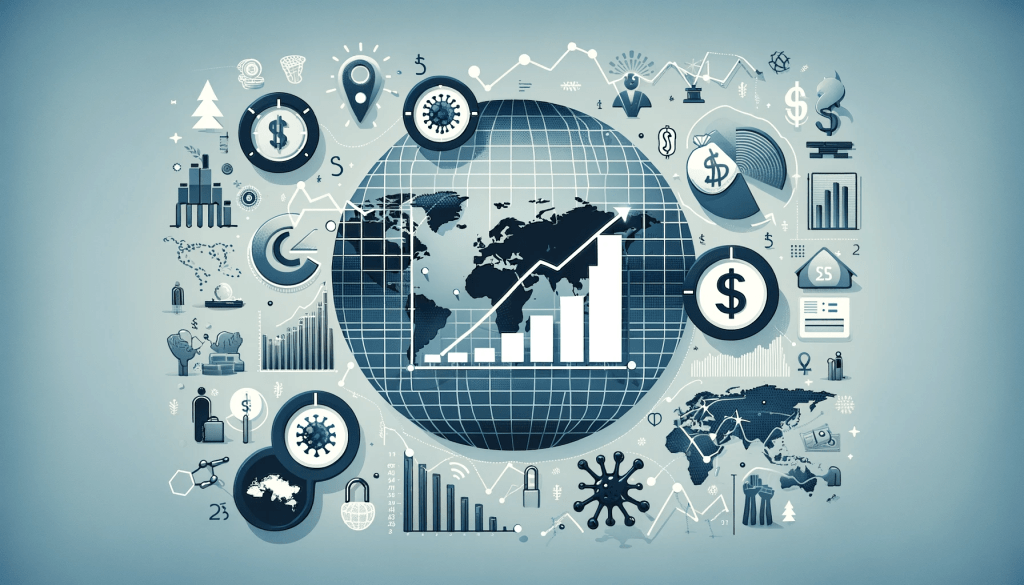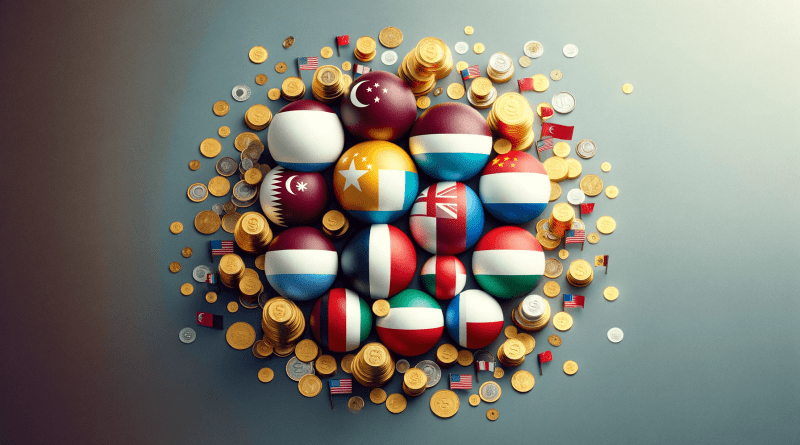Top 5 Richest Countries in the World
When pondering the world’s richest countries, images of grandeur, advanced technology, and economic prowess often come to mind. The notion of a “rich” country typically conjures up the United States or vast nations like China; however, wealth is not solely the domain of the large and the populous. Many of the planet’s wealthiest countries are also among its smallest.
Countries such as San Marino, Luxembourg, Switzerland, and Singapore have defied expectations by combining their sophisticated financial sectors, advantageous tax regimes, and strategic economic policies to attract copious amounts of foreign investment and professional talent. Others, like Qatar and the United Arab Emirates, harness their extensive reserves of natural resources to bolster their economic standing. In the case of Macao, the allure of its casinos has cemented its status as one of the five wealthiest countries in the world despite recent challenges.
However, wealth is a complex tapestry woven from various economic indicators and global events. The gross domestic product (GDP) is often the go-to metric for assessing the economic output of a nation. Still, more is needed to paint the complete picture of individual prosperity. This is where purchasing power parity (PPP) and gross national income (GNI) come into play, offering a more nuanced view of a country’s standard of living.
In this article, we delve into the multifaceted nature of wealth, exploring the factors that contribute to a country’s affluence, the impact of global events on economic status, and the intricate methods of measuring wealth. Join us as we uncover the top 5 richest countries in the world, not just through their GDP but by evaluating their actual economic standing in the face of global challenges and disparities.
Factors That Contribute to a Country’s Wealth
Financial Sectors and Tax Regimes
The wealth of a nation can often be traced to its financial sector and the tax policies it employs. Countries like Luxembourg and Singapore have developed sophisticated financial services industries that are robust and attractive to foreign investors. These nations offer favorable tax rates and financial privacy, which, in turn, lead to significant banking deposits from abroad and the establishment of multinational corporations within their borders.
Natural Resources and Tourism
On the other side of the spectrum, countries such as Qatar and the United Arab Emirates owe much of their affluence to their abundant natural resources. Qatar, in particular, has utilized its hydrocarbon reserves to amass wealth that disproportionally exceeds its relatively small population. Similarly, Macao’s prosperity has been bolstered by its tourism sector, specifically through its gaming and gambling industries, which attract visitors from around the globe.
Resilience and Adaptability
However, financial and natural advantages alone do not cement a country’s status as wealthy. Resilience and adaptability to global economic trends are equally important. For instance, throughout the pandemic and subsequent economic challenges, nations like Ireland and Luxembourg have demonstrated remarkable economic resilience, partly due to their flexible economic policies and the ability to attract tech giants and other multinational companies seeking favorable corporate tax arrangements.
The Impact of Global Events on Wealth

Pandemic and Economic Disparities
The COVID-19 pandemic has served as a stark reminder of the fragility of global economies, unveiling the deep-rooted disparities within even the richest nations. While countries like Macao and Qatar boast impressive wealth on paper, the pandemic highlighted the unequal distribution of resources. In Macao, the tourism and gambling sectors suffered significant losses due to travel restrictions, demonstrating the volatility of relying on a single economic pillar.
In Qatar, despite the affluence brought on by its oil and gas reserves, the pandemic exposed the vulnerability of low-income migrant workers and the challenges in healthcare and housing they face. These instances illustrate that high PPP or GDP figures may mask underlying inequalities that can destabilize a country’s economy during unforeseen global events.
Inflation and Cost of Living Crises
The economic fallout has been further compounded by global inflation and geopolitical conflicts, such as the Russia-Ukraine war. These crises have led to a spike in the cost of living, with lower-income families in wealthy countries disproportionately affected. The increase in the prices of essentials like housing, food, and energy has outpaced income growth, pushing many to the brink of financial insecurity.
Wealth Growth Disparities
While the top 5 richest countries have seen their per-capita purchasing power soar, the gap between them and the poorer nations has only widened. According to the International Monetary Fund (IMF), the disparity in wealth growth is staggering, with the richest countries seeing a growth in per-capita purchasing power by more than $5,000. In contrast, the poorest countries experienced a meager increase of $30.
Measuring Wealth: GDP vs. PPP vs. GNI
Understanding Economic Indicators
Economic prosperity is often quantified by the gross domestic product (GDP), which measures the total value of goods and services produced over a specific period. It is a broad indicator of economic activity and is often used as a benchmark for comparing the financial performance of different countries. However, GDP alone can be misleading as it does not account for the population size or the cost of living.
This is where purchasing power parity (PPP) comes into play. PPP provides a more accurate measure of economic well-being by accounting for the cost of living and inflation rates. It offers a glimpse into what people can afford in their country, as opposed to GDP, which doesn’t reflect income distribution or individual purchasing power.
Gross National Income (GNI), on the other hand, includes the total domestic and foreign output claimed by residents of a country. It accounts for the money flowing in and out of a country, offering a clearer picture of a nation’s economic health and the wealth of its citizens. GNI is particularly useful for understanding the financial flows in countries that serve as tax havens, where a substantial portion of the GDP may be generated from foreign investments.
Tax Shelters and the Distortion of Wealth
The presence of tax havens can distort the perceived wealth of a nation. Countries like Ireland and Luxembourg have high GDPs partly because they are the fiscal residences of numerous multinational corporations. These tax strategies can inflate a country’s GDP, thereby skewing the perception of its wealth.
The Real Measure of Prosperity
For an accurate measure of a country’s prosperity, one must look beyond GDP. By considering both PPP and GNI, we can obtain a more comprehensive understanding of the standard of living within a country. These indicators help us discern whether the average citizen benefits from the nation’s reported economic prosperity.
Top 5 Richest Countries in the World
5. Macao SAR
Economic Profile: Once predicted to overtake others in wealth, Macao SAR’s economy centers on its gaming industry. Its prosperity, measured by a PPP of $89,558, has been tested by the pandemic, which caused a sharp decline from its peak of $125,000 in 2019.
Current Challenges: The COVID-19 impact on global travel and Macao’s reliance on its casino-driven economy reveal vulnerabilities in its economic structure. Macao is slowly recovering, striving to diversify its economy beyond gaming and tourism.
4. Qatar
Economic Profile: With a PPP of $124,834, Qatar’s wealth stems from its hydrocarbon reserves. Despite fluctuations in oil prices, Qatar has maintained its status as one of the wealthiest nations for two decades due to its small population and vast natural resources.
Current Challenges: The initial pandemic response exposed the gap between the wealthy and the low-income migrant workers. Despite this, Qatar’s economy showed resilience with projected growth due to its hosting of the World Cup and increased oil and gas revenues.
3. Singapore
Economic Profile: Known for its trade and financial hub status, Singapore’s PPP stands at $133,895. The nation has transformed from a developing country to a modern industrial economy with nearly universal literacy among its adult population.
Current Challenges: Singapore faced economic contraction during the pandemic, particularly in its manufacturing sector. Its recovery is ongoing, with efforts to mitigate the impact of external economic pressures, such as China’s slowdown, on its economy.
2. Luxembourg
Economic Profile: Luxembourg’s robust economy, with a PPP of $131,580, is supported by a solid financial sector and high living standards. It offers an attractive environment for businesses and individuals seeking stability and services.
Current Challenges: The pandemic’s economic shock was less severe here, but the tiny nation is not immune to the broader European economic slowdown. Efforts to maintain growth focus on innovation and diversification beyond financial services.
1. Ireland
Economic Profile: Ireland’s recent economic history is a remarkable recovery, with a PPP of $140,694. Its growth has been partly fueled by its status as a corporate tax haven, drawing major tech companies to its shores.
Current Challenges: Despite its wealth, there is a significant income disparity among its population. With plans to adjust its corporate tax rate to 15% by 2024, Ireland may face new economic dynamics that could affect its wealth status.
Looking Beyond the Numbers
Wealth Distribution Within Rich Countries
The 5 wealthiest countries in the world present an image of economic success, but this wealth is only sometimes evenly distributed among their populations. Even in these affluent nations, there can be a significant divide between the wealthiest citizens and those struggling to meet basic needs. For instance, in Ireland, the top 20% of earners make almost five times more than the bottom 20%, a disparity reflected in many of the world’s richest countries.
Implications of Economic Disparities
Such disparities have tangible implications for social cohesion and the overall quality of life. In countries where wealth is concentrated in the hands of a few, the average citizen may experience a lower standard of living, as suggested by GDP or PPP statistics. This calls into question the utility of these measures as sole indicators of a country’s prosperity and the well-being of its people.
Future Economic Trends
As we look to the future, it is clear that the richest countries will continue to face challenges in sustaining their economic growth and managing wealth distribution. The potential realignment of corporate tax rates, as planned by Ireland, could reshape investment patterns and impact national revenues. Additionally, the ongoing effects of global events, such as the pandemic and geopolitical conflicts, will likely continue to test the resilience of these economies.
What Did We Learn Today?
Reflecting on Wealth and Prosperity
In exploring the top 5 richest countries in the world, we’ve traversed beyond mere economic statistics to understand what constitutes a nation’s wealth. While countries like Macao, Qatar, Singapore, Luxembourg, and Ireland showcase impressive GDP and PPP figures, these numbers only tell part of the story.
Beyond GDP: A Holistic View of Wealth
Our journey has highlighted the critical importance of considering a range of economic indicators, including GNI and acknowledging the impact of global events on national economies. Real wealth encompasses not only financial prosperity but also social equity and the ability to withstand economic fluctuations.
The Future of Global Wealth
Looking ahead, the challenge for these wealthy nations will be to sustain their economic standing while addressing internal inequalities and preparing for global economic shifts, including potential changes in tax policies and the ongoing repercussions of the pandemic and geopolitical tensions.
Key Takeaways
- Wealth is multifaceted, and countries must aim for economic resilience and fair wealth distribution.
- Economic indicators such as GDP, PPP, and GNI each provide valuable insights but also have limitations.
- Global events can significantly impact the perceived and actual wealth of nations.
Final Thoughts
As we consider the 5 wealthiest countries in the world, we are reminded that wealth is as much about the quality of life and access to opportunities as it is about numbers in a ledger. The accurate measure of a country’s richness lies in its ability to provide for all its citizens, offering a stable, secure, and prosperous society.

